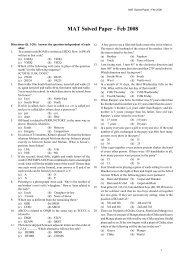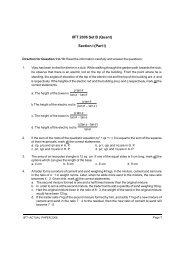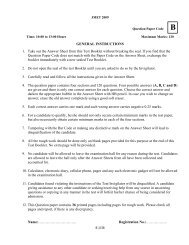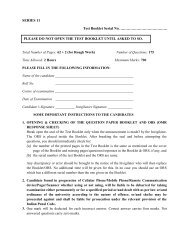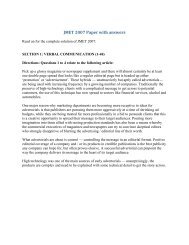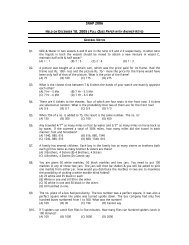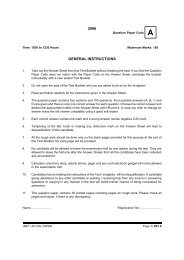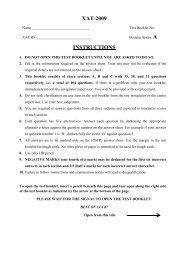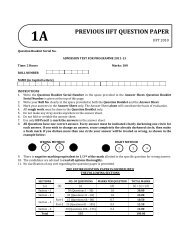PREVIOUS FMS QUESTION PAPER
PREVIOUS FMS QUESTION PAPER
PREVIOUS FMS QUESTION PAPER
Create successful ePaper yourself
Turn your PDF publications into a flip-book with our unique Google optimized e-Paper software.
Directions for Question Nos. 1 to 15: Read the<br />
following passage-1 and answer the questions given at<br />
the end of the passage. The answers should be based<br />
either on the author's views or inferences drawn from<br />
the given passage.<br />
Passage – 1<br />
The fairness exercise, thus structured, is aimed at<br />
identifying appropriate principles that would<br />
determine the choice of just institutions needed for the<br />
basic structure of a society. Rawls identifies some very<br />
specific principles of justice (to be discussed presently),<br />
and makes the strong claim that these principles would<br />
be the unanimous choice that would emerge from the<br />
political conception of justice as fairness. He argues<br />
that since these principles would be chosen by all in the<br />
original position, with its primordial equality, they<br />
constitute the appropriate ‘political conception’ of<br />
justice, and that people growing up in a well-ordered<br />
society governed by these principles would have good<br />
reason to affirm a sense of justice based on them<br />
(irrespective of each person’s particular conception of a<br />
‘good life’ and personal ‘comprehensive’ priorities). So<br />
the unanimous choice of these principles of justice does<br />
quite a bit of work in the Rawlsian system, which<br />
includes the choice of institutions for the basic<br />
structure of the society, as well as the determination of<br />
a political conception of justice, which Rawls presumes<br />
will correspondingly influence individual behaviours in<br />
conformity with that shared conception.<br />
The choice of basic principles of justice is the first act in<br />
Rawls’s multi-staged unfolding of social justice. This<br />
first stage leads to the next, ‘constitutional’, stage in<br />
which actual institutions are selected in line with the<br />
chosen principle of justice, taking note of the conditions<br />
of each particular society. The working of these<br />
institutions, in turn, leads to further social decisions at<br />
later stages in the Rawlsian system, for example<br />
through appropriate legislation (in what Rawls calls<br />
‘the legislative stage’). The imagined sequence moves<br />
forward step by step on firmly specified lines, with an<br />
elaborately characterized unfolding of completely just<br />
societal arrangements.<br />
PP-02<br />
SECTION I<br />
English Comprehension(50 questions)<br />
The whole process of this unfolding is based on the<br />
emergence of what he describes as ‘two principles of<br />
justice’ in the first stage that influence everything else<br />
that happens in the Rawlsian sequence. I have to<br />
express considerable scepticism about Rawls’s highly<br />
specific claim about the unique choice, in the original<br />
position, of one particular set of principles for just<br />
institutions, needed for a fully just society. There are<br />
genuinely plural, and sometimes conflicting, general<br />
concerns that bear on our understanding of justice.<br />
They need not differ in the convenient way– convenient<br />
for choice that is- that only one such set of principles<br />
really incorporates impartiality and fairness, while the<br />
others do not. Many of them share features of being<br />
unbiased and dispassionate, and represent maxims that<br />
their proponents can ‘will to be a universal law’ (to use<br />
Immanuel Kant’s famous requirement).<br />
Indeed, plurality of unbiased principles can, I would<br />
argue, reflect the fact that impartiality can take many<br />
different forms and have quite distinct manifestations.<br />
For example, in the illustration with the competing<br />
claims of three children over a flute, considered in the<br />
Introduction, underlying each child’s claim there is a<br />
general theory of how to treat people in an unbiased<br />
and impartial way, focusing, respectively, on effective<br />
use and utility, economic equity and distributional<br />
fairness, and the entitlement to the fruits of one’s<br />
unaided efforts. Their arguments are perfectly general,<br />
and their respective reasoning about the nature of a<br />
just society reflects different basic ideas that can each<br />
be defended impartially (rather than being parasitic on<br />
vested interests). And if there is no unique emergence<br />
of a given set of principles of justice that together<br />
identify the institutions needed for the basic structure<br />
of the society, then the entire procedure of ‘justice as<br />
fairness’, as developed in Rawls’s classic theory, would<br />
be hard to use.<br />
As was discussed in the Introduction, Rawls’s basic<br />
claim of the emergence of a unique set of principles of<br />
justice in the original position (discussed and defended<br />
in his A Theory of Justice) is considerably softened and<br />
qualified in his later writings. Indeed, in his Justice as<br />
Fairness: A Restatement, Rawls notes that ‘there are





